Sep 29, 2009
Canon PowerShot SD940 IS Digital ELPH Review

Here’s a review of the Canon PowerShot SD940 Digital ELPH, also known as the Digital IXUS 120 IS, Canon’s latest ultra-compact camera for fall 2009! Also head on to the Canon SD940 Digital ELPH/Digital IXUS 120 IS photo gallery for sample photos. Hit the link for the full review of the camera.
DPInterface Canon PowerShot SD940 IS Digital ELPH/Digital IXUS 120 IS Review
Brad Soo – September 29th, 2009 (Updated September 30th, 2009)

Ever wanted a tiny Digital ELPH/IXUS camera with a wide-angle lens? The new PowerShot SD940 IS Digital ELPH is like a mash-up of the petite SD780 Digital ELPH/IXUS 100 and the famous SD880 Digital ELPH/IXUS 870 – taking the best features from the two cameras and putting them into one $300 ultra-compact body. The Canon PowerShot SD940 Digital ELPH has 12 megapixels of resolution, a 4X lens that starts at 28 mm, 2.7 inch LCD screen, a 720p movie mode and point-and-shoot operation.
Is the Canon PowerShot SD940 Digital ELPH the tiny camera you’ve been waiting for?
The camera has three names: it’s called the Canon PowerShot SD940 IS Digital ELPH in the US, while in Europe, Asia and everywhere else, it’s called the Canon Digital IXUS 120 IS. And in Japan, the same camera sells under the IXY DIGITAL name.
Size and Weight
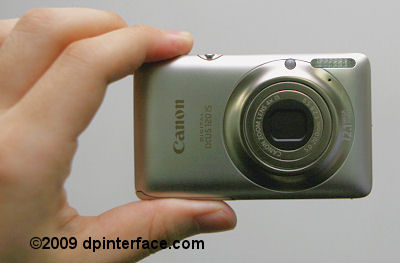
(159.9) 87.0 x 54.5 x 18.4 mm (115 g) - Canon PowerShot SD780 IS Digital ELPH
(159.9) 89.5 x 54.9 x 20.0 mm (120 g) - Canon PowerShot SD940 IS Digital ELPH
(172.8) 97.1 x 59.4 x 16.3 mm (121 g) – Casio Exilim FS10
(172.8) 98.2 x 54.9 x 20.1 mm (112 g) – Casio Exilim Z280
(172.8) 96.5 x 55.9 x 20.3 mm (130 g) – Casio Exilim Z450
(175.2) 89.0 x 57.9 x 23.9 mm (115 g) - Fujifilm FinePix Z37
(166.0) 90.0 x 53.0 x 23.0 mm (120 g) – Nikon Coolpix S620
(166.0) 91.0 x 55.0 x 20.5 mm (110 g) – Nikon Coolpix S640
(173.1) 95.0 x 57.0 x 22.4 mm (106 g) – Olympus FE4000
(173.1) 97.5 x 55.7 x 26.2 mm (125 g) – Olympus Stylus 7010
(173.1) 95.7 x 59.6 x 20.2 mm (131 g) - Panasonic Lumix FP8
(176.7) 97.0 x 57.9 x 21.8 mm (126 g) - Panasonic Lumix FS25
(172.5) 97.0 x 54.0 x 21.5 mm (105 g) – Pentax Optio P80
(167.7) 99.8 x 59.7 x 18.5 mm (149 g) – Samsung Dual View TL220
(172.0) 97.9 x 57.8 x 16.3 mm (124 g) - Sony Cyber-shot T900
(165.8) 93.8 x 58.2 x 16.5 mm (119 g) - Sony Cyber-shot TX1
(165.8) 90.5 x 51.8 x 19.8 mm (120 g) - Sony Cyber-shot WX1
All the weight figures above show when the camera is empty without a battery or memory card
The Canon PowerShot SD940 IS Digital ELPH is the smallest, and one of the lightest, ultra-compact cameras in its class and you’ll appreciate its tiny size (buttons are decently sized too). Just a little note, all of the cameras above are pocketable, and I’d be worried for the size of the buttons on the back if the SD940 got any smaller.
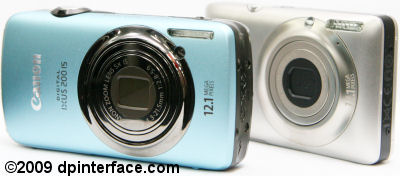
The Canon PowerShot SD940 Digital ELPH is also slightly smaller than its more expensive, touchscreen sibling, the PowerShot SD980 Digital ELPH.
Box packaging
The Canon PowerShot SD940 IS Digital ELPH comes with an average bundle:
- Rechargeable lithium-ion battery (NB-4L)
- Battery charger
- Wrist strap
- USB and A/V cables
- Camera software CD
- User’s manual
Canon doesn’t include any memory card or internal memory with the PowerShot SD940 Digital ELPH, so you’ll have to use your own. You’ll have to use your own SD/SDHC memory cards on the SD940 ELPH and I would suggest at least a 4 GB SDHC to start with. The Canon SD940 Digital ELPH is able to perform faster with a high-speed memory card (a speed rating of 60X to 80X is sufficient).
210 shots - Canon PowerShot SD780 IS Digital ELPH
220 shots - Canon PowerShot SD940 IS Digital ELPH
250 shots – Casio Exilim Z280
550 shots – Casio Exilim Z450
200 shots - Fujifilm FinePix Z37
250 shots – Nikon Coolpix S620
270 shots – Nikon Coolpix S640
205 shots – Olympus FE4000
170 shots – Olympus Stylus 7010
380 shots - Panasonic Lumix FP8
330 shots - Panasonic Lumix FS25
200 shots – Pentax Optio P80
200 shots – Samsung Dual View TL220
200 shots - Sony Cyber-shot T900
250 shots – Sony Cyber-shot TX1
350 shots – Sony Cyber-shot WX1
All the cameras above are rated with rechargeable batteries according to CIPA Standard
The Canon PowerShot SD940 IS Digital ELPH uses the same, tiny NB-4L rechargeable lithium-ion battery that has been around for quite a number of years. While there’s a small 5% increase in battery life compared to its sibling, the SD940 Digital ELPH’s 220 shot per charge battery life rating is merely on par with other ultra-compact cameras.
Accessories
The accessory range for the Canon SD940 IS Digital ELPH isn’t large but is probably sufficient for most casual shooters. You’ll find an AC adapter, slave flash, waterproof case and various camera cases available for the camera. You can also opt to pick up an optional HDMI cable (which can actually be found at most electronic stores) to connect the SD940 Digital ELPH to your high-def television set.
Camera Tour
The Canon PowerShot SD940 aka IXUS 120 has your standard issue Digital ELPH/IXUS box-and-circle design with some rounded-off edges reminiscent of the 2008 SD770’s design. The camera is stylish and pleasant to use with good ergonomics and has just three decently-sized buttons plus a navigation pad on the back. My only complaint is that I’m not a big fan of the tiny mode switch. Build quality is great since the camera feels pretty hardy.
If you’ve used any other Canon compact camera before, you’ll feel right at home with the SD940 Digital ELPH whose menu layout remains consistent with previous models but the user interface design has been given a slight refresh with Canon’s new orange/metallic color scheme and new help tooltips for each and every function.
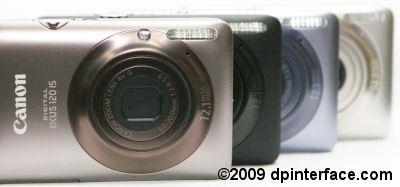
The Canon PowerShot SD940 IS Digital ELPH aka Digital IXUS 120 IS comes in your choice of four colors (and I had a chance to see and feel them all in-person): brown, black, blue and silver. One strange thing I found is that three of the colors come with a ‘smooth’ finish while the black model of the SD940 has a more textured, sandpaper-like finish and feel… so if you want all the grip you can ever get on a compact camera – or just like black-matte cameras – I’d suggest you pick the black model of the SD940 Digital ELPH.
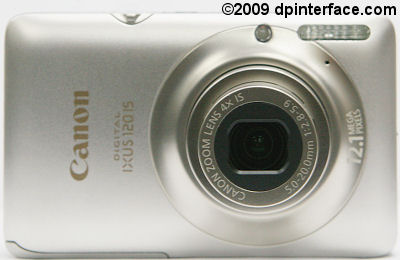
The Canon PowerShot SD940 Digital ELPH features the same 4X optical zoom lens as the famous SD880. The lens covers 28 – 112 mm in 35 mm terms and has an aperture range of f2.8 to f5.9. Well, the lens is a little slow at the telephoto end but it’s still better in terms of focal coverage and aperture range than the SD780’s 3.3X lens. Of course, the PowerShot SD940’s lens has optical image stabilization as well, to help reduce blurring caused by camera shake.
To the upper right of the lens is a small microphone hole for recording sound as well as the SD940’s flash unit. The flash has a range of 30 cm to 4.0 m at wide-angle and 50 cm to 2.0 m at telephoto (both at Auto ISO), which is by no means powerful, but still on par with other cameras of its class. The only other item on the front of the PowerShot SD940 is the autofocus assist beam/self-timer lamp, which is the small round window near the flash.
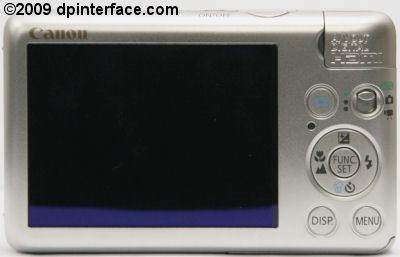
On the back of the Canon PowerShot SD940 IS Digital ELPH is a 2.7 inch LCD. While it isn’t as big as the 3 inch displays found on upper-tier Digital ELPH models, at least it’s bigger than the 2.5 inch displays of preceding models. The SD940’s LCD has a decent resolution of 230,000 pixels and it’s very sharp most of the time. Visibility in low-light was good (though the display image becomes a little grainy as it brightens up) and things are the same with bright light around too. There’s no optical viewfinder on the PowerShot SD940 Digital ELPH, in case you hadn’t noticed.
All of the PowerShot SD940’s controls are located on the right side of the camera, making one-handed operation easy. At the very top, above all the controls, is a cover which hides the camera’s connectivity ports. Open up the cover and you’ll find a single mini-B jack (for USB and A/V Out connectivity) and mini HDMI port.
Below the cover over the ports are the playback button and mode switch. The mode switch moves you between Smart Auto, program/scene modes and movie mode. One thing I don’t like is that the mode switch is on the tiny side: you’ll have to use your fingernail in order to operate it.
Smart Auto mode is Canon’s replacement for regular auto mode – the changes are behind the scenes where the camera’s processor is able to handle and determine appropriate shooting settings more intelligently based on the scene in front of the lens. For the person behind the camera, all you have to do is literally point the camera at your subject, press the shutter button and snap.
Next up is the SD940’s five way navigation pad, and situated nearby is the camera’s activity indicator lamp. You’ll notice that Canon now puts the dedicated print/shortcut button only on more expensive camera models (the SD940 isn’t one of them, which means you’ll have to enter the playback menu for print settings). Moving on, let’s take a look at the navigation pad:
- Up – Exposure compensation (+/-2 EV in 1/3 steps)
- Down – Self-timer (Off, face self-timer, normal self-timer [2 or 10 seconds])
- Left - Focus mode (Normal, macro, landscape)
- Right - Flash setting (Auto, on, slow sync, redeye reduction, off; some settings can be changed in the flash settings menu)
- Center – Function menu/Set
The Canon PowerShot SD940 IS Digital ELPH aka Digital IXUS 100 IS has a Face Self-timer mode, which works in conjunction with the camera’s face detection technology. The camera will watch the scene until an ‘extra face’ is detected, before starting the countdown to take picture/pictures.
Pressing the center button brings up the Function menu which contains several settings. The function menu has been revamped with Canon’s 2009 interface design – it’s prettier and almost as functional, though it takes an additional one button press on average to change settings:
- Sub-shooting mode (Program, portrait, night scene, kids & pets, indoor, other scene modes)
- ISO (Auto, 80, 100, 200, 400, 800, 1600)
- White balance (Auto, daylight, cloudy, tungsten, fluorescent, fluorescent H, custom)
- My Colors (Normal, vivid, vivid [blue/green/red], neutral, sepia, black & white, positive film, lighter/darker skin tone, custom)
- Metering method (Evaluative, center-weighted, spot)
- Drive mode (Single-shot, continuous shooting)
- Image size and compression
The custom option in the My Colors/Photo Effects area enables you to manually tweak contrast, saturation, sharpness and individual red, green, blue and skin tone levels; all up to +/- 2 in 1 step increments)
The last two buttons are DISPLAY (toggles on-screen info) and MENU buttons.

There are just three things on the top of the Canon PowerShot SD940 IS Digital ELPH: the speaker (three holes), the power button and shutter button with the zoom controller wrapped around it.
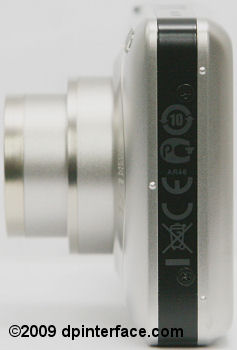
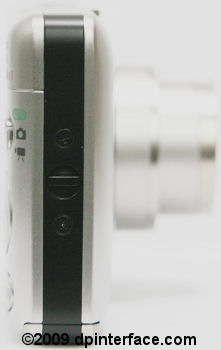
One side of the PowerShot SD940 Digital ELPH is blank, while on the other side, you’ll find the wrist strap loop.

At the bottom of the PowerShot SD940 Digital ELPH, you’ll find its metal tripod mount and the battery/memory card compartment. The door doesn’t feel very flimsy, but it isn’t exactly rock solid either.
Taking pictures (Shooting mode)
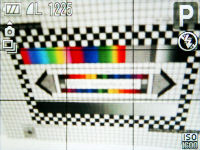
The Canon PowerShot SD940 Digital ELPH aka Digital IXUS 120 shows you plenty of on-screen information. That includes shooting details, exposure info, a 3-step battery indicator and compositional gridlines for framing your photos. One thing that the camera lacks is a live histogram for judging image brightness.
The 12 megapixel SD940 IS Digital ELPH allows you to choose from multiple image sizes and compression modes to suit your needs. You can choose to use full 12 MP, 8 MP, 5 MP, 2 MP, VGA and widescreen (at 8.3 MP). There are also two image compression modes here: Fine and Standard. A 2 GB card will hold about 625 Fine-quality photos at 12 megapixels.
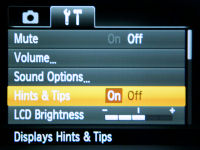
Just about every Canon camera introduced this year features their 2009 user interface design. The main changes I spotted on cameras from earlier this year (such as the PowerShot SX1) include enlarged font size, a fancier black and orange color scheme and overall, better readability. One feature that’s new on the SD940 Digital ELPH is the ‘helps and tips’ feature, which displays a small one to two line tooltip below the menu for each function – if you think you’re Mr or Ms Know-it-all, then you can opt to turn off the hints and tips feature in the camera’s setup menu.
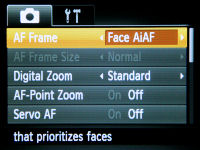
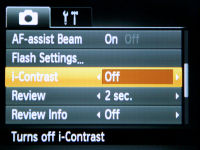
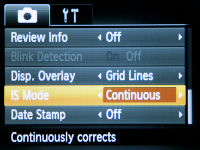
Let’s have a look at those menu options now:
- Autofocus mode (Face detection, center AF)
- AF point size (Normal, small) – Choose how size of the camera’s focusing point area
- Digital zoom – you should keep this turned off, it lowers picture quality
- AF point zoom – magnify the area the camera focuses on
- Servo AF – Turning this on will make the camera focus continuously; turn it off and the camera only auto focuses when you half-press the shutter button
- AF assist beam – to help the camera focus in low-light
- Flash settings – adjust red-eye reduction and slow sync
- iContrast – see below
- Review – This option decides whether the camera will show the image on the LCD screen right after the picture is taken
- Review info
- Blink detection – checks for any closed eyes in your photo and alerts you about them
- Display overlay (Off, grid lines, 3:2 ratio guide)
- IS (Image stabilization) Mode – Off, Continuous, Shoot-only, Panning
- Date stamp (Off, date, date and time)
The camera’s iContrast feature brightens dark areas of your photos with four selectable options (Off, auto, low, medium, high). iContrast works but the difference it makes is subtle and not extreme.
Scene modes and macro
The SD940 Digital ELPH is primarily a point-and-shoot camera and doesn’t have any manual exposure controls. The scene modes you’ll find are: portrait, foliage, snow, beach, sunset, fireworks, aquarium, underwater, ISO 3200, indoor, kids & pets, night snapshot, color accent, color swap, long shutter and stitch assist.
Probably the only other manual control besides white balance that you’ll find on the SD940 is long exposure mode; buried with the camera’s other scene modes, “Long Shutter” mode allows you to manually select a shutter speed between 1 to 15 seconds to take low-light/night shots.
The SD940 IS Digital ELPH has a good macro mode with a minimum focusing distance of 3 cm at wide-angle. You can also select Digital Macro, which allows you to utilize the camera’s 4X digital zoom to enlarge your subject (but this will also reduce picture quality).
Face detection
The SD940 Digital ELPH has face detection and blink detection. Both face and blink detection worked well based on my experience with the camera, though the camera did wrongly detect a subject’s eyes being closed (when they were not) once. Blink detection is still pretty handy; especially if you’re the type who takes a lot of people photos, as it displays an unobtrusive on-screen alert if the camera detects any of your subject(s) eyes being closed while the photo was taken. Finally, a software-based redeye removal system takes care of redeye in flash photos (that worked well too).
Video Recording
The Canon PowerShot SD940 IS Digital ELPH aka Digital IXUS 120 is one of the numerous cameras introduced this fall with a 720p HD movie mode. The camera is able to record 1280 x 720 video clips with mono sound at 30 FPS. Movies are recorded using the H.264 MOV recording codec, which is a fairly efficient format.
A 2 GB memory card will hold a little over 10 minutes worth of 720p HD or 24 minutes of VGA video. Though you can double movie recording times with a 4 GB card, do note the usual file size/time limitation here – each movie recorded can be up to 4 GB or 10 minutes (HD)/60 minutes (VGA and QVGA) per clip, whichever comes first.
Besides 720p HD video, you can opt to lower resolution to VGA (640 X 480) or QVGA (320 X 240) to extend recording time greatly. At both of those resolutions, videos are still recorded at 30 FPS with sound.
You can use color accent, color swap and activate optical image stabilization while recording movies. Exposure is automatically adjusted. You can also use digital zoom while recording but not optical zoom. Overall movie quality was good with decent sound.
Performance
All performance testing of the Canon PowerShot SD940 IS Digital ELPH aka Digital IXUS 120 was performed using a high-speed 4 GB SanDisk Ultra II SDHC (90X) card.
The Canon PowerShot SD940 Digital ELPH starts up very quickly in one second. Focusing was generally very good – with decent lighting around, it takes 0.1 to 0.3 seconds to lock focus; in low-light, expect to wait around 0.5 to 1 second. Focusing was accurate as well, including low-light situations.
- Shot-to-shot speed - 1 shot every 1.6 seconds, above average
- Flash recharge time using a fully charged battery - 3 seconds on average
I haven’t been a big fan of the frame rate of 12 megapixel compact cameras this year, and sadly, it’s the same case with the PowerShot SD940 Digital ELPH. The camera shoots at a sluggish 0.8 frames per second (even with a fast shutter speed of 1/320) in continuous shooting mode – that’s one picture every 1.25 seconds. You can shoot endlessly until the memory card fills up, but judging by the frame rate, it’ll probably take ages to fill up a large card.
The camera zooms from wide-angle to telephoto rather noisy in about 1.4 seconds while shut down time with the lens at telephoto takes about 1.2 seconds.
I was pleased (though not blown away) with the Canon PowerShot SD940 Digital ELPH’s performance, which was above average in most areas. The continuous shooting area has become one of the weaknesses of compact cameras as their megapixel count goes up, up and away… the PowerShot SD940 doesn’t take any measures to counter this and suffers from sluggish continuous shooting.
Image Quality
Now, let’s have a look at the Canon PowerShot SD940 IS Digital ELPH aka Digital IXUS 120’s image quality characteristics:







In general, the Canon PowerShot SD940 Digital ELPH produces clean and sharp looking photos at ISO 80, 100 and 200, suitable for various uses from large prints to desktop wallpaper. Starting at ISO 400, you’ll start to notice the effects of noise reduction – that is, detail smudging occurs and images start to turn a bit soft. Still, you’ll be able to make medium sized to large prints at this point.
Detail loss and noise levels aren’t that much worse at ISO 800, the only thing here is the obvious drop in color saturation. More smudging and saturation loss occurs at ISO 1600, and you should save this setting (along with ISO 3200) for 4 x 6 prints only. The ISO 3200 setting comes as a scene mode and image resolution is automatically fixed to 2 MP only.

Surprisingly, lens distortion isn’t very prominent on the SD940 Digital ELPH, even with its 4X lens that starts at 28 mm. However, there’s some corner softness and very noticeable color fringing (chromatic aberration) towards the edges of the frame. Redeye is not an issue as the camera’s software-based redeye removal system immediately does away with any redeye the camera can find after taking a photo with flash. If that doesn’t work, you can manually pinpoint and remove redeye using the tool in playback mode.
I think the Canon PowerShot SD940 Digital ELPH’s strong point over the competition is its image quality. The camera doesn’t over-utilize noise reduction or other aspects of image processing that usually make photos look soft or ‘fake’/artificial. Noise is well controlled with good levels of detail and color accuracy maintained till ISO 400. From ISO 800 onwards, saturation starts to decrease (something that seems to happen with most compact cameras) but image quality is still usable for small to midsize prints/display. That said, the SD940 Digital ELPH isn’t totally perfect – you’ll have to watch out for color fringing, especially in high contrast photos.
Photo gallery
Take a look at full-sized photos taken by the Canon PowerShot SD940 IS Digital ELPH aka Digital IXUS 100 IS in the photo gallery.
Playback
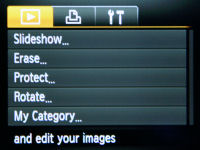
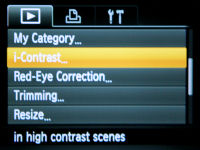

The PowerShot SD940 IS Digital ELPH aka Digital IXUS 120 has the same fancy playback mode as Canon’s other compact cameras. You can view photos and play videos you’ve taken, complete with transition effects as you browse. You can perform basic things on files such as print marking, image protection, resizing, trimming and rotation. You can magnify photos by 10X and pan around using the navigation pad.
Images can be viewed individually, in sets of thumbnails (what’s new on the SD940 is Canon now allows you to choose from several sets of thumbnails by using ‘zoom out’ on the zoom controller, from 4 to 130 thumbnails), by category, date, folder or file type (movies or photos). There’s even a fancy slideshow feature that allows you to play back photos/video with sound and transition effects. The category function is handy as allows you to tag and organize photos into several preset categories.

The PowerShot SD940 Digital ELPH has three playback editing tools for still photos. You can also apply My Colors (photo effects) as seen in the screen above, or you can brighten photos (iContrast) and manually remove redeye if you want. There are no movie editing tools besides a ‘trim’ function that allows you to cut the beginning/end of movie clips.
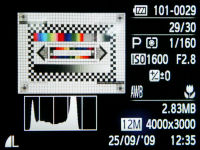
By default, the Canon PowerShot SD940 IS Digital ELPH tells you only the basics about your photos but you can bring up shooting details, mode, exposure information (with shutter speed and aperture value) and a histogram. There’s also an overexposure alert feature which “blinks” overexposed areas of your photos to warn you about them.
Conclusion
Like the tiny and pretty designs of Canon’s Digital ELPH/IXUS cameras but also desire a 28 mm wide-angle lens? The PowerShot SD940 IS Digital ELPH aka Digital IXUS 120 is Canon’s latest ultra-compact which lets you have your cake and eat it too. In more ways than one, the SD940 Digital ELPH is a lot like the SD780 I reviewed earlier this year – tiny, well-constructed, has 12 megapixels of resolution, a 720p HD movie mode and all – but pairs all that with a slightly larger 2.7 inch LCD and the 4X wide-angle zoom lens found on larger ELPH/IXUS models such as the S880.
Like its siblings and predecessors, the SD940 Digital ELPH remains a point-and-shoot camera. The camera is geared towards casual shooters with its array of scene modes and auto convenience features such as face/blink detection and Smart Auto mode. The only ‘manual’ controls are manual white balance and long shutter mode.
As I mentioned, the camera is small and well-built, though I didn’t quite care for the tiny mode switch and just average compartment door. If someone’s gonna make a camera with good build quality, why not put in the effort and do everything right? I’m also fairly puzzled why the black colored SD940 Digital ELPH (I handled several different models and they all felt the same) has a more textured feel than the other three colors… so there’s an extra reason to get a black camera – slightly better ergonomics in a way.
The camera offers good performance in all areas except continuous shooting speed. Focusing and press-to-shot speeds were very fast and shot-to-shot was better than most cameras. What’s even more impressive than performance is the SD940 Digital ELPH’s image quality. The pictures it produced were very good with low noise, vivid colors and the only main flaw being above average color fringing (which you can remove in computer software if it irritates you)
All-in-all, I’d recommend the Canon PowerShot SD940 Digital ELPH aka Digital IXUS 120 for those wanting a capable point-and-shoot camera which produces good image quality. It’s a good pick over its sibling, the SD780, mainly due to the wider, faster zoom lens… and it’s also better than most competitors in terms of image quality and speed.
What’s hot:
- Very good image quality till ISO 800; ISO 3200 salvageable for tiny 4 x 6 prints
- Above average camera performance (Except continuous shooting)
- New ‘hints and tips’ feature should prove useful for beginners
- Smart Auto and a decent selection of scene modes
- 720p HD movie mode with sound; HDMI output for your movies
- Fancy convenience features: face & blink detection, face self-timer, effective red-eye removal tool
What’s not:
- Lacks manual controls and a live histogram
- Visible, above average color fringing
- Only black model has textured finish, other three colors are more smooth/slippery
- Sluggish continuous shooting rate
- Tiny mode switch; so-so memory card/battery door quality
Camera rating: (Ratings guide)
- 4.0 - Design and build quality
- 3.0 - Bundle (in the box)
- 4.0 - Lens (Zoom, aperture range, image stabilization)
- 4.0 - Feature set and controls
- 3.0 - Ergonomics and ease of use
- 4.0 - Performance and speed
- 4.5 - Image quality
- 3.8 over 5.0 - Overall rating














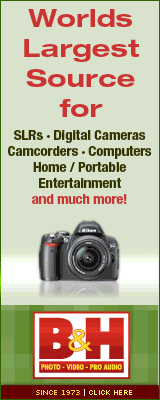

Thank you for the great site (and reviews) I am researching cameras and have narrowed it to the sd970 and sd940 (maybe the sd880 but they cant be found) We have 2 young children but we aren’t ready to go dslr yet….we like having something portable. We had the a640 but it crapped out and lacked image stabilization. We tried out the sd990 and returned it because we wanted a bit more zoom and/or width. In terms of image quality, low light and performance, which of the cameras would you recommend?….I am leaning towards the 940 because of the wide angle and because I heard the sd970s zoom was too narrow and did not perform in low light. What’s your take? Thank you in advance.
Well, seeing that wide-angle seems to be your priority, I would think the getting the SD940 would be more suitable. The 28 mm lens of the SD940 is approximately 32% wider than the SD970’s lens that starts at 37 mm (the SD940 is also slightly cheaper). If you need even more wide-angle power, there’s always the Canon SD980 with a 3 inch touchscreen and a lens that starts at 24 mm (really, really wide-angle!). Hope this helps
Thanks for the fast reply. Do you think the 940 is a suitable family point and shoot?….the only appealing thing about the 970 was the 5x zoom but I read that it is too narrow….. I looked at the 980 but I was not a big fan of the touch screen and menu. Thanks again.
Yes, I do believe that the SD940 is good as a family P-&-S camera. Most of the time, people tend to appreciate the wide-angle end of the lens better… as you mention, you seem to be concerned about the wide-angle coverage of the lens. For indoor, group and vacation photos, the wide-angle end of the lens of the SD940 will probably come in handy, more than the SD970’s 5X zoom reach will.
Thanks for your review. I think this model is good for everyone.
I would like to know which one you recommend for taking pictures of my kids? I am looking overall for great picture quality, sharpness and that when I press the shutter button, it will take the pic right away so I wont miss my baby’s smile. Which would you recommend the SD 940 is, or the SD 980 is?
Hi Shana, I apologize for the delayed reply as the recent launch of the Olympus PEN E-P2 has been keeping me very busy over the last 36 hours. Both the SD940 and SD980 are great cameras, it just depends if you need the touchscreen and ultra-wide angle lens of the SD980 or the smaller size of the SD940.
Hi! I found your review very helpfull!
Sorry if my writting isn´t too good, it’s not my first language
I want to get one of these two cameras, SD940 or SD780, and I can´t decide wich one is better.
I´m not too much of a pro, and right now I don´t own any camera, so both will be good enough for me, but still want to make the best buy posible, cause for me it´ll cost a lot of money.
I liked the SD780 because of the viewfinder, to take pics saving battery when it´s low.
But I´ve read that the lens in the SD940 it´s better, but I don´t know in wich way and if that´s worth the money and loosing the viewfinder.
Also read that it’s better for low-light pics and it has a bigger LCD.
Could you give me a quick comparison between them?
Thanks in advance!
Gonzalo from Argentina.
Brad,
I’ve had a SD20 for years and absolutely love the minature size — I’ve been able to take quality pictures with it (on occasion) and by and large it gets the job done. It still works great and I’m hesitant to upgrade given how easy and small it is.
Nevertheless, I’ve been looking to upgrade to increase the quality of my shots and I like the idea of incorporating HD video in the same device. I’ve looked at both the SD780 and SD940 online and I’m torn on whether it is worth the $60-80 more for the SD940. As you can probably tell from my use of the SD20 for many years, I’m capable of getting by with no zoom, but given the closeness in size of the 780 and 940, I at least wanted to get your input. Seems to me that the SD740 is the smallest device out there (ignoring my SD20) and not yet understanding the real benefit I get from going to the 940 as far as lense angle is concerned. Can you explain in an easy example what the effective difference is?
Thanks
Joe
Hi Joe, the SD940 is a great camera, if you can find it at a lower price gap vs the SD780, then you should definitely go for it. A wide-angle lens would mean that you can pack more “frame” into a single photo. Let’s say you were to take a group picture of friends in a confined space (typically indoors in a living room, club, cafe/restaurant, other tight spaces)… and let’s say, using a camera with a 35 mm lens (your SD20 is 37 mm if I remember correctly and the SD940 is 33 mm), you are able to fit 4 people into a single frame. By standing in the exact same spot but using a ‘wide-angle’ 28 mm lens (which the SD940 has), you would be able to fit 5 people in a single photo thanks to the wider coverage. A 28 mm works out to be exactly 25% wider than a 35 mm lens, which is useful in photos of architecture, landscapes, people photos, etc.
Not to mention the SD940 has a larger LCD, slightly more powerful flash and better lens aperture range than the SD780 (Lens aperture range of f2.8 - f5.9 on SD940, f3.2 - f5.8 on SD780). What this means is the SD940’s lens is able to take in slightly more light, enabling the camera to use slightly faster shutter speeds. This, in turn, can reduce the chances of blurring.
Hope this helps. If you need any further advice or have more questions, I’d be glad to answer them.
—
Reply to Gonzalo
Hi Gonzalo, glad my review helped. You’ve pretty much summed the differences up correctly. The SD940 has a slightly larger LCD and a better lens, while the SD780 has a viewfinder (it’s very small, but still useful to conserve battery life like you said). Image quality is apparently very similar between both cameras, so I wouldn’t worry too much about that. The SD940 can probably perform better in low-light, however, not because of image quality… but because its lens has a slightly better aperture range and flash is more powerful at wide-angle.
Hope this helps. If you need any further advice or have more questions, I’d be glad to answer them.
Thanks Brad!
I’ll go for the SD940, the wider angle will come in handy for landscape photos in my trips.
I hope it’s not too expensive, besides adding a 4GB SDHC and maybe an extra battery. Can you give me a hint on the prices of these things over there?
It’s just to have an idea cause they’re bringing it from Puerto Rico and it’s probably cost a bit more.
And one last question, is there a lot of diference in memory speeds for this kind of camera? I read that there are different speeds like 150X,120X…
Thanks a lot!!
Gonzalo
Sorry, I’m here again!
I’m having trouble finding the right memory, there are so many, and not all of them specify the speed or class the same way.
Looking for the 10MB/s found the SanDisk 4GB “Ultra II” and “Extreme III” version that says that have (15MB/s read) but doesn´t specify write speed. One is class 4 and the other class 6. (these are between $15 and $20 online & $36 in Sears)
Then there’s Patriot with model “LX” 8GB that’s says class 10, and its $30 (with double capacity)
The problem is that I have to give my friend good info cause she doesn’t know anything about this and don’t want to buy the wrong one.
I’d be glad if you can give me a hint how should I tell her what to look for. Brands, models, anything.
Thanks!!
Hi Gonzalo, it’s no problem at all that you’re here again =). In fact I apologize for the delayed reply (usually I reply within hours) because I’ve been down with a slight cold this week . I think the SanDisk Ultra II would do fine for the camera. The Patriot card sounds like an excellent deal too. You won’t go wrong with either I guess.
Hi Brad,
Your review is very helpful!!
I am planning to buy a camera and after reading your comments and in detail explaination about lens and wide angle, I narrowed down to SD940. But I am also considering nikon S640 which has very similar specification to a SD940. Could you tell me which one of them is better if you have any knowledge about nikon cameras?
Thank you in advance.
Lawanya
Hi Lawanya, thank you for your comment. I have reviewed the Nikon Coolpix S640 and I would say the Canon SD940 is the better of the two if you want an all-rounder camera. The S640 produces just decent image quality and has a few specific compromises, while the SD940 has most angles covered with not as many major flaws (though it costs about $30 more than the S640 at the moment. Hope this helps - Brad
Thanks for a great review! I’m trying to decide between a refurb sd880 and a new sd940. Any thoughts? Seems like people really love the 880 and think the 940 is just adequate but I can’t tell if it’s because technology has come a long way in the past year or two or if the 880 is simply a better camera? I’m looking to use this mainly in low light- concerts, flash snapshots and outdoor night shots as well as underwater with a housing. I realize point n shoots aren’t the best for this but that’s how I would use a pocket camera. Thanks in advance for any advice you can offer!
Hi Gonzalo, glad to hear from you so quickly. The Canon SD940 is currently going for $260 (USD) and the SD780 is going for $210 (USD), so you might wanna use a currency converter like xe.com to compare prices (I think B&H photo video does sales outside of the US too, with shipping charges of course). I would recommend a memory card with around 60X speed (10MB/s), anything higher such as 120X or 150X would be overkill as the camera’s processor can’t even reach those speeds when processing/writing into the memory card.
Thanks for the info on the memory! you confirmed what I thought that ultra-speed memory wasn’t necesary for this one.
Nice site that B&H, but a friend is coming from PR and it’s bringing the cam with him…that’s why I wanted to know the price in USA, to compare with the one in PR. Here it’s between U$S396 and U$S424.
Thanx for everything!
Gonzalo